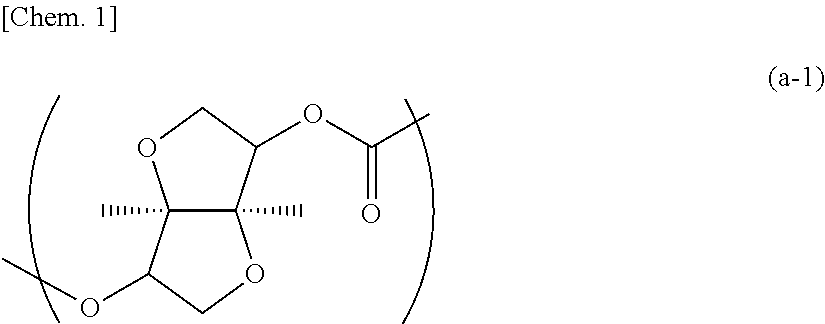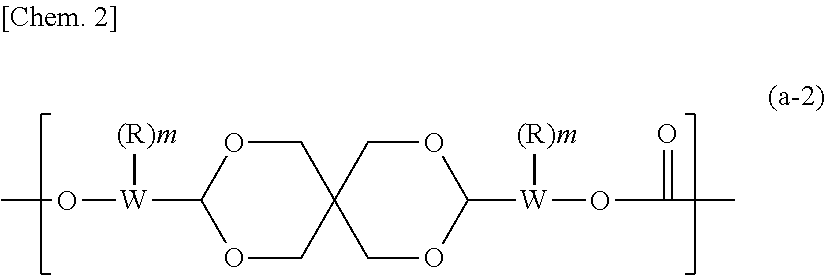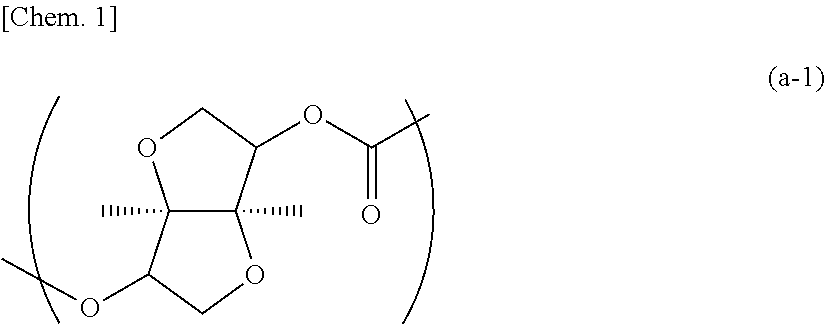Resin composition and film formed from same
a technology applied in the field of resin composition and film formed from same, can solve the problems of poor weather resistance and optical properties such as photoelastic coefficient, and the use of acrylic resins in applications involving direct touching by humans is limited, and achieves excellent transparency, low photoelastic coefficient, and good weather resistance. good
- Summary
- Abstract
- Description
- Claims
- Application Information
AI Technical Summary
Benefits of technology
Problems solved by technology
Method used
Image
Examples
example 1
[0133]Under a nitrogen atmosphere, 351 parts of isosorbide (abbreviated as ISS hereinafter), 313 parts of 3,9-bis(2-hydroxy-1,1-dimethylethyl)-2,4,8,10-tetraoxaspiro(5,5)undecane (abbreviated as SPG hereinafter), 750 parts of diphenyl carbonate (abbreviated as DPC hereinafter), and 0.8×10−2 parts of tetramethylammonium hydroxide, and 0.6×10−4 parts of barium stearate as catalysts were heated to 200° C. and the mixture was melted. Then, the temperature was raised to 220° C. and the decompression degree was adjusted to 20.0 kPa over 30 minutes. Thereafter, the temperature was raised to 240° C. and the decompression degree was adjusted to 10 kPa over further 30 minutes. The mixture was maintained at that temperature for 10 minutes, and then the decompression degree was adjusted to 133 Pa or less over 1 hour. After completion of the reaction, the mixture was discharged from the bottom of the reaction tank under pressurized nitrogen and cut with a pelletizer, while cooling in a water tan...
example 2
[0136]The operation was performed in exactly the same manner as in Example 1, except that a film was extruded at a blend weight ratio of PC1:PMMA1=90 / 10, followed by evaluations in the same manner. The results are shown in Table 1.
example 3
[0137]The operation was performed in exactly the same manner as in Example 1, except that 451 parts of ISS, 104 parts of SPG, and 750 parts of DPC were used as raw material and a film was extruded at a blend weight ratio of PC2:PMMA1=80 / 20, followed by evaluations in the same manner. The results are shown in Table 1.
PUM
| Property | Measurement | Unit |
|---|---|---|
| mol % | aaaaa | aaaaa |
| mol % | aaaaa | aaaaa |
| glass transition temperature | aaaaa | aaaaa |
Abstract
Description
Claims
Application Information
 Login to view more
Login to view more - R&D Engineer
- R&D Manager
- IP Professional
- Industry Leading Data Capabilities
- Powerful AI technology
- Patent DNA Extraction
Browse by: Latest US Patents, China's latest patents, Technical Efficacy Thesaurus, Application Domain, Technology Topic.
© 2024 PatSnap. All rights reserved.Legal|Privacy policy|Modern Slavery Act Transparency Statement|Sitemap



